Superpower
A superpower is a state with a dominant position characterized by its extensive ability to exert influence or project power on a global scale. This is done through the combined means of economic, military, technological and cultural strength as well as diplomatic and soft power influence. Traditionally, superpowers are preeminent among the great powers.
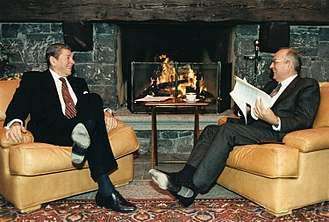
The term was first applied post World War II to the United States and the Soviet Union. For the duration of the Cold War, the United States and the Soviet Union dominated world affairs. At the end of the Cold War and the dissolution of the Soviet Union in 1991, only the United States appeared to be a superpower.[1][2][3] Alice Lyman Miller defines a superpower as "a country that has the capacity to project dominating power and influence anywhere in the world, and sometimes, in more than one region of the globe at a time, and so may plausibly attain the status of global hegemony".[4] Few countries have the potential to become superpowers; China is now considered an economic superpower, but it arguably lacks several factors including military and soft power to be widely recognized as a global superpower.[5][6]
Terminology and origin
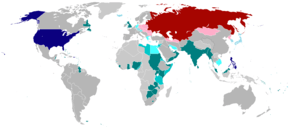
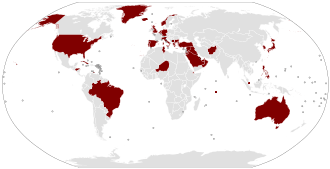
No agreed definition of what is a superpower exists and may differ between sources.[2] However, a fundamental characteristic that is consistent with all definitions of a superpower is a nation or state that has mastered the seven dimensions of state power, namely geography, population, economy, resources, military, diplomacy and national identity.[7]
The term was first used to describe nations with greater than great power status as early as 1944, but only gained its specific meaning with regard to the United States and the Soviet Union after World War II. This was because the United States and the Soviet Union had proved themselves to be capable of casting great influence in global politics and military dominance. The term in its current political meaning was coined by Dutch-American geostrategist Nicholas Spykman in a series of lectures in 1943 about the potential shape of a new post-war world order. This formed the foundation for the book The Geography of the Peace, which referred primarily to the unmatched maritime global supremacy of the British Empire and United States as essential for peace and prosperity in the world.
A year later in 1944, William T. R. Fox, an American foreign policy professor, elaborated on the concept in the book The Superpowers: The United States, Britain and the Soviet Union — Their Responsibility for Peace which spoke of the global reach of a super-empowered nation.[8] Fox used the word superpower to identify a new category of power able to occupy the highest status in a world in which—as the war then raging demonstrated—states could challenge and fight each other on a global scale. According to him, at that moment there were three states that were superpowers, namely the United States, the Soviet Union and the United Kingdom. The British Empire was the most extensive empire in world history and considered the foremost great power, holding sway over 25% of the world's population[9] and controlling about 25% of the Earth's total land area, while the United States and the Soviet Union grew in power before and during World War II. The UK would face serious political, financial and colonial issues after World War II that left it unable to match Soviet or American power. Ultimately, Britain's empire would gradually dissolve over the course of the 20th century, sharply reducing its global power projection.
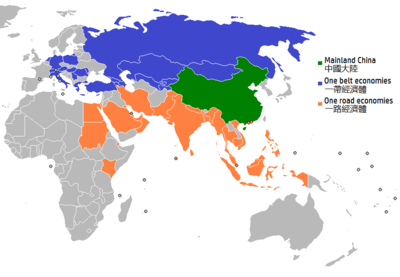
According to Lyman Miller, "[t]he basic components of superpower stature may be measured along four axes of power: military, economic, political, and cultural (or what political scientist Joseph Nye has termed "soft power")".[4]
In the opinion of Kim Richard Nossal of Queen's University in Canada, "generally this term was used to signify a political community that occupied a continental-sized landmass, had a sizable population (relative at least to other major powers); a superordinate economic capacity, including ample indigenous supplies of food and natural resources; enjoyed a high degree of non-dependence on international intercourse; and, most importantly, had a well-developed nuclear capacity (eventually normally defined as second strike capability)".[2]
In the opinion of Professor Paul Dukes, "a superpower must be able to conduct a global strategy including the possibility of destroying the world; to command vast economic potential and influence; and to present a universal ideology". Although "many modifications may be made to this basic definition".[11] According to Professor June Teufel Dreyer, "[a] superpower must be able to project its power, soft and hard, globally".[12] In his book Superpower: Three Choices for America's Role in the World, Dr. Ian Bremmer, president of the Eurasia Group, argues that a superpower is "a country that can exert enough military, political, and economic power to persuade nations in every region of the world to take important actions they would not otherwise take".[13]
Apart from its common denotation of the foremost post-WWII states, the term superpower has colloquially been applied by some authors retrospectively to describe various preeminent ancient great empires or medieval great powers, in works such as Channel 5 (UK)'s documentary Rome: The World's First Superpower or the reference in The New Cambridge Medieval History to "the other superpower, Sasanian Persia".[14]
Cold War

The 1956 Suez Crisis suggested that Britain, financially weakened by two world wars, could not then pursue its foreign policy objectives on an equal footing with the new superpowers without sacrificing convertibility of its reserve currency as a central goal of policy.[15] As the majority of World War II had been fought far from its national boundaries, the United States had not suffered the industrial destruction nor massive civilian casualties that marked the wartime situation of the countries in Europe or Asia. The war had reinforced the position of the United States as the world's largest long-term creditor nation[16] and its principal supplier of goods; moreover it had built up a strong industrial and technological infrastructure that had greatly advanced its military strength into a primary position on the global stage.[17] Despite attempts to create multinational coalitions or legislative bodies (such as the United Nations), it became increasingly clear that the superpowers had very different visions about what the post-war world ought to look like and after the withdrawal of British aid to Greece in 1947 the United States took the lead in containing Soviet expansion in the Cold War.[18]
The two countries opposed each other ideologically, politically, militarily, and economically. The Soviet Union promoted the ideology of Marxism–Leninism, planned economy and a one-party state whilst the United States promoted the ideologies of liberal democracy and the free market in a capitalist market economy. This was reflected in the Warsaw Pact and NATO military alliances, respectively, as most of Europe became aligned with either the United States or the Soviet Union. These alliances implied that these two nations were part of an emerging bipolar world, in contrast with a previously multipolar world.
The idea that the Cold War period revolved around only two blocs, or even only two nations, has been challenged by some scholars in the post–Cold War era, who have noted that the bipolar world only exists if one ignores all of the various movements and conflicts that occurred without influence from either of the two superpowers.[19] Additionally, much of the conflict between the superpowers was fought in proxy wars which more often than not involved issues more complex than the standard Cold War oppositions.[20]
After the Soviet Union disintegrated in the early 1990s, the term hyperpower began to be applied to the United States as the sole remaining superpower of the Cold War era.[2] This term, popularized by French foreign minister Hubert Védrine in the late 1990s, is controversial and the validity of classifying the United States in this way is disputed. One notable opponent to this theory is Samuel P. Huntington, who rejects this theory in favor of a multipolar balance of power. Other international relations theorists such as Henry Kissinger theorize that because the threat of the Soviet Union no longer exists to formerly American-dominated regions such as Western Europe and Japan, American influence is only declining since the end of the Cold War because such regions no longer need protection or have necessarily similar foreign policies as the United States.[21]
The Soviet Union and the United States fulfilled the superpower criteria in the following ways:
| Demography | Had a population of 286.7 million in 1989, the third largest on Earth behind China and India.[22] | Had a population of 248.7 million in 1990, at that time the fourth largest on Earth behind China, India and the Soviet Union.[23] |
|---|---|---|
| Geography | Largest state in the world (actually a federal superstate), with a surface area of 22,270,000 km2 (8,600,000 sq mi).[22] | Fourth largest country in the world, with an area of 9,630,000 km2 (3,720,000 sq mi).[24] |
| Economy | GNP of $2.7 trillion in 1990 (equivalent to $5.3 trillion in 2019). Second largest economy in the world.[25] Enormous mineral energy resources and fuel supply. Generally self-sufficient using a minimal amount of imports, although it suffered resource inadequacies such as in agriculture. Large-scale industrial production directed by centralised state organs leading to a high degree of inefficiency. Five-year plans frequently used to accomplish economic goals. Economic benefits such as guaranteed employment, free healthcare and free education provided to all levels of society. Soviet life expectancy and certain indicators of healthcare performance exceeded those of the United States, but often fell below the standards of the most developed Western European states. Economy tied to Central and Eastern-European satellite states. | GNP of $5.2 trillion in 1990 (equivalent to $10.2 trillion in 2019). Largest economy in the world.[25] Capitalist market economic theory based on supply and demand in which production was determined by customers' demands, although it also included rising income inequality since 1979.[26] Enormous industrial base and a large and modernized farming industry. Large volume of imports and exports. Large resources of minerals, energy resources, metals and timber. High standard of living with accessibility to many manufactured goods. Home to a multitude of the largest global corporations. United States dollar served as the dominant world reserve currency under Bretton Woods Conference. Allied with G7 major economies. Supported allied countries' economies via such programmes as the Marshall Plan. |
| Politics | Strong Marxist–Leninist state with extensive secret police apparatus, organized under a quasi-parliamentary system with strong fusion of powers, with checks and balances for both the executive and the judiciary primarily based on commanding the legislature's confidence. The Supreme Soviet enjoyed de facto parliamentary sovereignty despite a written constitution and nominal federalism as no court was vested with judicial review. As no formal office of President has existed, the standing legislature also served as a collective head of state. The only national-level popular elections were the quinquennial elections to the Supreme Soviet which were yes-or-no votes on candidates handpicked beforehand. However, radical government reforms in 1989 introduced competitive elections, a directly-elected executive President and a Constitutional Court, both having rudimentary separation of powers from the existing components of the system. One-party system with the Communist Party having an institutionalized monopoly of power. Permanent seat on the United Nations Security Council. | Strong liberal constitutional republic, organized under a presidential system with strong separation of powers, with a complicated system of checks and balances exercised between the legislature, the executive and the judiciary. The legislative powers of the United States Congress were limited both by the written constitution and by the federal nature of the national government. Despite the lack of a dedicated Constitutional Court, judicial review of laws has been vested in the Supreme Court by judicial precedent. The President was both head of state and head of government and his cabinet was not required to command congressional confidence. The only national popular elections were the biennial congressional elections. However. the quadrennial presidential election has de facto changed from an indirect election by an Electoral College into a direct, although weighted, popular election. Two-party system between Democrats and Republicans. Permanent seat on the United Nations Security Council along with two allies (France and the United Kingdom). |
| Foreign relations | Strong ties with Central and Eastern Europe, countries in Latin America, Southeast Asia and Africa. Also had an alliance with China up until 1961. Supported Marxist–Leninist countries around the world. | Strong ties with Western Europe, some countries in Latin America, the Commonwealth of Nations, several East Asian countries and Israel. Supported liberal democracies and anti-communist dictatorships around the world. |
| Military | Possessed largest armed forces and air force in the world and the second of the world's largest navies. Possessed bases around the world. Held the world's largest stockpile of nuclear weapons for the second half of the Cold War. Founder of Warsaw Pact with satellite states in Central and Eastern Europe. Global intelligence network with the GRU and the First Chief Directorate of the KGB. Ties with paramilitary and guerrilla groups in the developing world. Large arms industry production with global distribution. | Highest military expenditure in the world,[27] with the world's largest navy surpassing the next 13 largest navies combined[28][29] and an army and air force rivaled only by that of the Soviet Union. Possessed bases around the world, particularly in an incomplete ring bordering the Warsaw Pact to the West, South and East. Largest nuclear arsenal in the world during the first half of the Cold War. Powerful military allies in Western Europe with their own nuclear capabilities. Global intelligence networks with the Intelligence Community. Ties with paramilitary and guerrilla groups in the developing world. Large armament production through defense contractors along with its developed allies for the global market. |
| Media | Constitutional guarantees for freedom of speech and freedom of the press were made conditional both for fulfilling one's citizen's duties and for conformity with the interests of the government, thereby turning them into effective dead letters. Press explicitly controlled and censored. Promoted through the use of propaganda its socialist ideal that workers of all countries should unite to overthrow capitalist society and what they called the dictatorship of the bourgeoisie and replace it with a socialist society where all means of production are publicly owned. | Maintained constitutional guarantees for freedom of speech and freedom of the press, although the ongoing Cold War did lead to a degree of censorship, particularly during the Vietnam War and the Second Red Scare when censorship was the heaviest. |
| Culture | Rich tradition in literature, film, classical music and ballet. | Rich tradition and worldwide cultural influence in music, literature, film, television, cuisine, art and fashion. |
Post–Cold War era

After the dissolution of the Soviet Union in 1991 which ended the Cold War, the post–Cold War world has in the past been considered by some to be a unipolar world,[30][31] with the United States as the world's sole remaining superpower.[32] In 1999, Samuel P. Huntington wrote: "The United States, of course, is the sole state with preeminence in every domain of power – economic, military, diplomatic, ideological, technological, and cultural – with the reach and capabilities to promote its interests in virtually every part of the world". However, Huntington rejected the claim that the world was unipolar, arguing: "There is now only one superpower. But that does not mean that the world is unipolar," describing it instead as "a strange hybrid, a uni-multipolar system with one superpower and several major powers". He further wrote that "Washington is blind to the fact that it no longer enjoys the dominance it had at the end of the Cold War. It must relearn the game of international politics as a major power, not a superpower, and make compromises".[33]
Experts argue that this older single-superpower assessment of global politics is too simplified, in part because of the difficulty in classifying the European Union at its current stage of development. Others argue that the notion of a superpower is outdated, considering complex global economic interdependencies and propose that the world is multipolar.[34][35][36][37]
A 2012 report by the National Intelligence Council predicted that the United States superpower status will have eroded to merely being first among equals by 2030, but that it would remain highest among the world's most powerful countries because of its influence in many different fields and global connections that the great regional powers of the time would not match.[38] Additionally, some experts have suggested the possibility of the United States losing its superpower status completely in the future, citing speculation of its decline in power relative to the rest of the world, economic hardships, a declining dollar, Cold War allies becoming less dependent on the United States, and the emergence of future powers around the world.[39][40][41][42] Others have pointed out that the US has four times the wealth of its nearest competitor China, and five to six times the military capacity, giving it a lead that will not soon be overcome.[43]
According to a RAND Corporation paper by American diplomat James Dobbins, Professor Howard J. Shatz, and policy analyst Ali Wyne, Russia in the breakdown of a disintegrating unipolar world order, whilst not a peer competitor to the United States, would still remain a player and a potential rogue state that would undermine global affairs. The West could contain Russia with methods like those employed during the cold war with the Soviet Union, though this would be tested by Russia's overt and covert efforts to destabilize Western alliances and political systems. On the other hand, China is a peer competitor to the United States that cannot be contained, and will be a far more challenging entity for the West to confront. The authors state that China's military dominance in the Asia-Pacific is already eroding American influence at a rapid pace, and the costs for the US to defend its interests there will continue to rise. Moreover, China's economic influence has already broken out of its regional confines long ago and is on track to directly contest the US role as the center for economic trade and commerce.[44][45][46][47]
However, while China is sometimes referred to as an emerging superpower that could in the near future potentially challenge the eroding status of the US as sole superpower, it still lacks several factors, particularly global military power.[43]
Potential superpowers
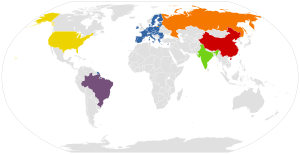
The term potential superpowers has been applied by scholars and other qualified commentators to the possibility of several political entities achieving superpower status in the 21st century. Due to their large markets, growing military strength, economic potential, and influence in international affairs, China,[48][49][50] the European Union,[51][52] India[53] and Russia[54] are among the political entities most cited as having the potential of achieving superpower status in the 21st century. In 2020, a new UBS survey found that 57% of global investors predicted that China would replace the U.S. as the world's biggest superpower by 2030.[55] However, many historians, writers and critics have expressed doubts whether any of these countries would ever emerge as a new superpower.[56][57] Some political scientists and other commentators have even suggested that such countries might simply be emerging powers, as opposed to potential superpowers.[58]
Besides those mentioned above, a limited number of observers have also discussed, although ultimately dismissed, Brazil having the potential to emerge as a superpower.[59]
The record of such predictions has admittedly not been perfect. For example, in the 1980s, some commentators thought Japan would become a superpower due to its large GDP and high economic growth at the time.[60] However, Japan's economy crashed in 1991, creating a long period of economic slump in the country which has become known as The Lost Years. As of August 2012, Japan had yet to fully recover from the 1991 crash.[61]
See also
- American Century
- Chinese Century
- Emerging power
- Great power
- Group of Two
- Hegemony
- Historic recurrence
- Hyperpower
- International relations theory
- List of modern great powers
- Middle power
- Monroe Doctrine
- NATO
- Potential superpowers
- Shanghai Cooperation Organisation
- Second Superpower
- Small power
- Unipolarity
References
- Bremer, Ian (May 28, 2015). "These Are the 5 Reasons Why the U.S. Remains the World's Only Superpower". Time.
- Kim Richard Nossal. Lonely Superpower or Unapologetic Hyperpower? Analyzing American Power in the post–Cold War Era. Biennial meeting, South African Political Studies Association, 29 June-2 July 1999. Retrieved 2007-02-28.
- From Colony to Superpower: U.S. Foreign Relations since 1776 (Published 2008), by Professor George C. Herring (Professor of History at Kentucky University)
- Miller, Lyman. "www.stanford.edu". stanford.edu. Retrieved 2010-08-27.
- Champion, Marc; Leung, Adrian (30 August 2018). "Does China Have What It Takes to Be a Superpower?". Bloomberg.com.
- Marcus, Jonathan (25 August 2019). "Is the US still Asia's only military superpower?". BBC News. Retrieved 2019-09-30.
- The Rise and Fall of the Great Powers (1987) written by Paul Kennedy
- Dellios, Rosita. "China: The 21st Century Superpower?" (PDF). Casa Asia. Retrieved 2010-08-27.
- Angus Maddison. The World Economy: A Millennial Perspective (p. 98, 242). OECD, Paris, 2001.
- Based on <一帶一路規劃藍圖> in Nanfang Daily
- "The Superpowers – A Short History". 8 December 2008. Archived from the original on 8 December 2008.CS1 maint: BOT: original-url status unknown (link)
- "PDF Version - Foreign Policy Research Institute" (PDF). www.fpri.org. Retrieved 2015-05-31.
- Bremmer, Ian. 2015. Portfolio (Penguin Group): New York.
- Cambridge (1995). The New Cambridge Medieval History: Volume 1, C.500-c.700. Cambridge University Press. p. 323. ISBN 9780521362917 – via Google Books.
- Adam Klug and Gregor W. Smith, 'Suez and Sterling', Explorations in Economic History, Vol. 36, No. 3 (July 1999), pp. 181–203.
- "Getting Serious About the Twin Deficits "by Author: Menzie D. Chinn - September 2005 by Council on Foreign Relations Press
- The Cold War: The Geography of Containment Gary E. Oldenburger by Oldenburger Independent Studies; December 2002
- Robert Frazier, 'Did Britain Start the Cold War? Bevin and the Truman Doctrine', Historical Journal, Vol. 27, No. 3 (Sep., 1984), pp. 715–727.
- Conflicts of Superpower by Signal Alpha News Achieve Press 2005
- Economic Interests, Party, and Ideology in Early Cold War Era U.S. Foreign Policy Archived 2012-09-28 at the Wayback Machine Benjamin O. Fordham by World Peace Foundation; Massachusetts Institute of Technology April 1998
- Henry Kissinger, Diplomacy, pp. 24, 26
- "Library of Congress Country Studies". Lcweb2.loc.gov. Retrieved 2010-08-27.
- "www.census.gov" (PDF). Retrieved 2010-08-27.
- "The Largest Countries In The World" (PDF). Retrieved 2019-11-08.
- "1990 CIA World Factbook". Central Intelligence Agency. Retrieved 2009-10-12.
- Stone, C.; Shaw, H.; Trisi, D.; Sherman, A. "A Guide to Statistics on Historical Trends in Income Inequality" (PDF). Center on Budget and Policy Priorities. pp. 7–11. Archived from the original (PDF) on 31 March 2015. Retrieved 2 October 2012.
- Pike, John. "World Wide Military Expenditures". Globalsecurity.org. Retrieved 2010-08-27.
- Gates, Robert M. "A Balanced Strategy: Reprogramming the Pentagon or a New Age". Council On Foreign Relations. Retrieved 31 May 2015.
- Weighing the US Navy Defense & Security Analysis, Volume 17, Issue 3 December 2001, pages 259–265
- Charles Krauthammer, The Unipolar Moment, Foreign Policy Magazine (1991).
- "www.gaikoforum.com" (PDF). Retrieved 2010-08-27.
- Country profile: United States of America, BBC News. Retrieved March 11, 2007.
- Huntington, Samuel P. (27 April 2006). "The Lonely Superpower". Foreign Affairs. Archived from the original on 27 April 2006.CS1 maint: BOT: original-url status unknown (link)
- Schwenninger, Sherle (December 5, 2003). "The Multipolar World Vs. The Superpower". The Globalist. Archived from the original on 2006-06-13. Retrieved 2006-06-10.
- Von Drehle, David (5 March 2006). "The Multipolar Unilateralist". The Washington Post. Retrieved 2006-06-10.
- "No Longer the "Lone" Superpower". Retrieved 2006-06-11.
- Henry C K Liu (April 5, 2003). "The war that may end the age of superpower". Asia Times. Retrieved 2006-06-11.
- Pike, John. "Forecast Sees Eroded U.S. Power".
- Unger J (2008), U.S. no longer superpower, now a besieged global power, scholars say University of Illinois
- Almond, Steve (2007-08-22). "Seizing American supremacy". Salon.com. Retrieved 2010-08-27.
- "The Coming End of the American Superpower". Counterpunch.org. 2005-03-01. Retrieved 2010-08-27.
- Martinez-Diaz, Leonardo (2007-04-28). "U.S.: A Losing Superpower?". Brookings.edu. Archived from the original on 2010-06-02. Retrieved 2010-08-27.
- Zhou, Christina (June 23, 2019). "Is America still the world's only superpower or is China a real rival? Experts aren't so sure anymore". Australian Broadcasting Corporation.
- Dobbins, James and Shatz, Howard and Wyne, Ali (2018). "Russia Is a Rogue, Not a Peer; China Is a Peer, Not a Rogue: Different Challenges, Different Responses". RAND Corporation. Cite journal requires
|journal=(help)CS1 maint: multiple names: authors list (link) - Maher, Paul J and Igou, Eric R and van Tilburg, Wijnand A.P. (January 16, 2018). "Brexit, Trump, and the Polarizing Effect of Disillusionment". Social Psychological and Personality Science. Sage Journals. 9 (2): 205–213. doi:10.1177/1948550617750737.CS1 maint: multiple names: authors list (link)
- Janjevic, Darko (September 18, 2018). "Vladimir Putin and Viktor Orban's special relationship". Deutsche Welle.
- King, Winnie (March 22, 2019). "Italy joins China's Belt and Road Initiative – here's how it exposes cracks in Europe and the G7". The Conversation (website).
- "What kind of superpower could China be?". 19 October 2012 – via www.bbc.co.uk.
- "China as a global power". China.usc.edu. 2007-11-13. Retrieved 2010-08-27.
- CNN (1999). Visions of China. CNN Specials, 1999. Retrieved on 2007-03-11 from http://www.cnn.com/SPECIALS/1999/china.50/asian.superpower/.
- Leonard, Mark (2005-02-18). Europe: the new superpower. Irish Times, 28 February 2005. Retrieved on 31-05-2015
- John McCormick,(2007). The European Superpower. Palgrave Macmillan.
- Meredith, R (2008) The Elephant and the Dragon: The Rise of India and China and What it Means for All of Us, "W.W Norton and Company" ISBN 978-0-393-33193-6
- Rosefielde, Steven (February 2005). Russia in the 21st Century. UNC Press. ISBN 978-0-521-54529-7.
- Saloway, Scott (24 January 2020). "China will replace the US as the world's biggest superpower by 2030: UBS survey". Yahoo Finance (UBS).
- Biswas, Soutik (2012-03-13). "Why India Will Not Become a Superpower". BBC India. Retrieved 2012-04-29.
- Yuanan, Zhang (2013-07-31). "Why China Is Still No Superpower". Retrieved 2014-03-14.
- "The Centre for Chinese Studies – Study of China and East Asia on the African continent" (PDF). www.ccs.org.za. Archived from the original (PDF) on 2013-12-04.
- Collecott, Peter (29 October 2011). "Brazil's Quest for Superpower Status". The Diplomatic Courier. Retrieved 10 August 2014.
- time.com 1988 article "Japan From Superrich To Superpower"
- Kihara, Leika (August 17, 2012). "Japan eyes end to decades long deflation". Reuters. Retrieved 2012-09-07.
Bibliography
- Belt, Don (2004). "Europe's Big Gamble". National Geographic. pp. 54–65.
- Brzezinski, Zbigniew (1997). The Grand Chessboard: American Primacy and Its Geostrategic Imperatives. New York: Basic Books. ISBN 0-465-02726-1.
- Fox, William (1944). The Super-powers: the United States, Britain, and the Soviet union—their responsibility for peace. Harcourt, Brace a. Co.
- Kamen, Henry (2003). Spain's Road To Empire: The Making Of A World Power, 1492–1763. Penguin640 pages
- Kennedy, Paul (1988). The Rise and Fall of the Great Powers. ISBN 0-679-72019-7.
- McCormick, John, John (2007). The European Superpower. Palgrave Macmillan.
- Todd, Emanuel (200X). After the Empire – The Breakdown of the American Order.
- Rosefielde, Steven (2005). Russia in the 21st Century: The Prodigal Superpower (PDF). Cambridge, UK: Cambridge University Press. ISBN 0-521-83678-6. Retrieved 2007-10-07.
- Erik Ringmar, "The Recognition Game: Soviet Russia Against the West," Cooperation & Conflict, 37:2, 2002. pp. 115–36. – an explanation of the relations between the superpowers in the 20th century based on the notion of recognition.
- Litwin Henryk, Central European Superpower, BUM Magazine, October 2016.
External links
| Wikimedia Commons has media related to Superpowers. |
- "To Paris, U.S. Looks Like a 'Hyperpower'". The International Herald Tribune. February 5, 1999. Archived from the original on October 26, 2006. Retrieved August 20, 2006.
- Last, Jonathan (October 21, 2005). "Rule America?". The Weekly Standard. News America Incorporated. Archived from the original on 2007-03-11. Retrieved 2006-09-15.
- Védrine, Hubert. France in an Age of Globalization, Brookings Institution Press, 2001. ISBN 0-8157-0007-5.
- "Word Spy - hyper-power". Retrieved 2006-09-15..
- Li, Bo; Zheng Yin (Chinese) (2001) 5000 years of Chinese history, Inner Mongolian People's publishing corp, ISBN 7-204-04420-7.
- CHAPTER FOUR. World Hegemony, 900-300 bce.